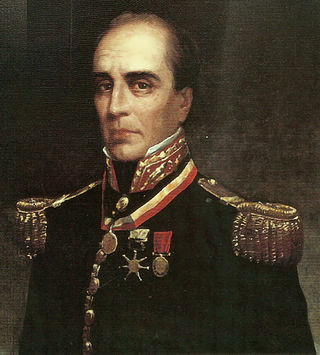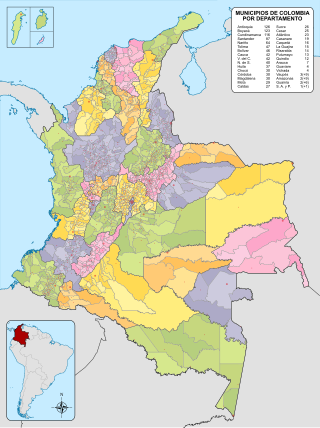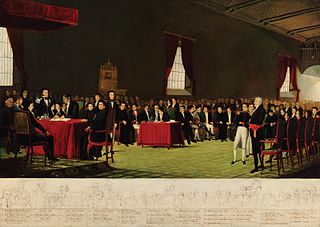Transport in Venezuela revolves around a system of highways and airports. Venezuela is connected to the world primarily via air and sea. In the south and east the Amazon rainforest region has limited cross-border transport; in the west, there is a mountainous border of over 1,375 miles (2,213 km) shared with Colombia. The Orinoco River is navigable by oceangoing vessels up to 400 km inland, and connects the major industrial city of Ciudad Guayana to the Atlantic Ocean.

Simón José Antonio de la Santísima Trinidad Bolívar Palacios Ponte y Blanco was a Venezuelan military and political leader who led what are currently the countries of Colombia, Venezuela, Ecuador, Peru, Panama, and Bolivia to independence from the Spanish Empire. He is known colloquially as El Libertador, or the Liberator of America.

Anzoátegui State is one of the 23 states of Venezuela, located in the northeastern region of the country. Anzoátegui is well known for its beaches that attract many visitors. Its coast consists of a single beach approximately 100 km (62 mi) long. Its capital is the city of Barcelona, and significant cities include Puerto la Cruz and El Tigre.

The Sucre State is one of the 23 states of Venezuela. The state capital is Cumaná city. Sucre State covers a total surface area of 11,800 km2 (4,600 sq mi) and, as of the 2011 census, had a population of 896,921. The most important river in the state is the Manzanares River.

Maturín is a city in Venezuela, the capital of the Venezuelan state of Monagas and a centre for instrumental exploration and development of the petroleum industry in Venezuela. The metropolitan area of Maturín has a population of 401,384 inhabitants. Maturín is also a busy regional transportation hub, connecting routes from the northeastern coast to the Orinoco Delta and the Gran Sabana.

Rafael José Urdaneta y Farías was a Venezuelan General and hero of the Spanish American wars of independence. He served as President of Gran Colombia from 1830 until 1831. He was an ardent supporter of Simón Bolívar and one of his most trusted and loyal allies.

The Palacio de Miraflores is the official residence of the President of Venezuela. It is located on Urdaneta Avenue, Libertador Bolivarian Municipality in Caracas.

Carúpano is a city in the eastern Venezuelan state of Sucre. It is located on the Venezuelan Caribbean coast at the opening of two valleys, some 120 km east of the capital of Sucre, Cumaná. This city is the shire town of the Bermúdez Municipality and, according to the 2010 Venezuelan census, the municipality has a population of 173,877 inhabitants. Carúpano is considered the gateway to the Paria Peninsula and its main commercial and financial center.

Puerto La Cruz is a port city located in Anzoátegui State, in Venezuela. It is the seat of the Juan Antonio Sotillo Municipality. The city has road connections to the state capital, Barcelona, to Lecheria and to Guanta.

The municipalities of Colombia are decentralized subdivisions of the Republic of Colombia. Municipalities make up most of the departments of Colombia with 1,122 municipalities (municipios). Each one of them is led by a mayor (alcalde) elected by popular vote and represents the maximum executive government official at a municipality level under the mandate of the governor of their department which is a representative of all municipalities in the department; municipalities are grouped to form departments.

The National Pantheon of Venezuela is a final resting place for national heroes. The Pantheon was created in the 1870s on the site of the ruined Santísima Trinidad church from 1744 on the northern edge of the old town of Caracas, Venezuela.

Francisco Burdett O'Connor was an officer in the Irish Legion of Simón Bolívar's army in Venezuela. He later became Chief of Staff to Antonio José de Sucre and Minister of War of Bolivia. Aside from Bolívar and Sucre, he is one of the few military officers of the Spanish American wars of independence to be bestowed the title of Libertador (Liberator).

The Liberator is a 2013 Spanish–Venezuelan historical drama film directed by Alberto Arvelo, starring Édgar Ramírez as Simón Bolívar. It was screened in the Special Presentation section at the 2013 Toronto International Film Festival. It was selected as the Venezuelan entry for the Best Foreign Language Film at the 87th Academy Awards, making the January Shortlist.

Alfonso Rumazo González was an Ecuadorian writer, historian, essayist and literary critic.
This is the list of members elected in the 2017 Constituent National Assembly of Venezuela following the 30 July 2017 elections. The first session of the assembly began on 4 August 2017 in the Oval Room of the Palacio Federal Legislativo. The Democratic Unity Roundtable—the opposition to the incumbent ruling party—also boycotted the election claiming that the Constituent Assembly was "a trick to keep [the incumbent ruling party] in power." Since the opposition did not participate in the election, the incumbent Great Patriotic Pole, dominated by the United Socialist Party of Venezuela, won almost all seats in the assembly by default.

The October 9 Revolution was a successful revolt against the Spanish Empire in Guayaquil on October 9, 1820. It was led by the General Antonio José de Sucre and directed by Simón Bolívar. The revolt established a revolutionary junta and created the Free Province of Guayaquil, an independent state. The independence of Guayaquil revived the war of independence of the Real Audiencia de Quito as part of the Spanish American wars of independence. Prominent events in the revolution include the uprising of the Spanish garrison in the city of Guayaquil and the control of the Pacific by the Liberating Expedition of Peru, under the command of José de San Martín.

The Venezuelan independence was the juridical-political process that put an end to the ties between the Captaincy General of Venezuela and the Spanish Empire. It also implied the replacement of the absolute monarchy by the republic as the form of government in Venezuela.
The Fifth Battle of Maturín was a military confrontation on 11 December 1814, that resulted in the epilogue of the Second Republic of Venezuela. The Royalist forces, which for two years had tried to conquer the city, destroyed the last great Patriot garrison that remained in the country.















